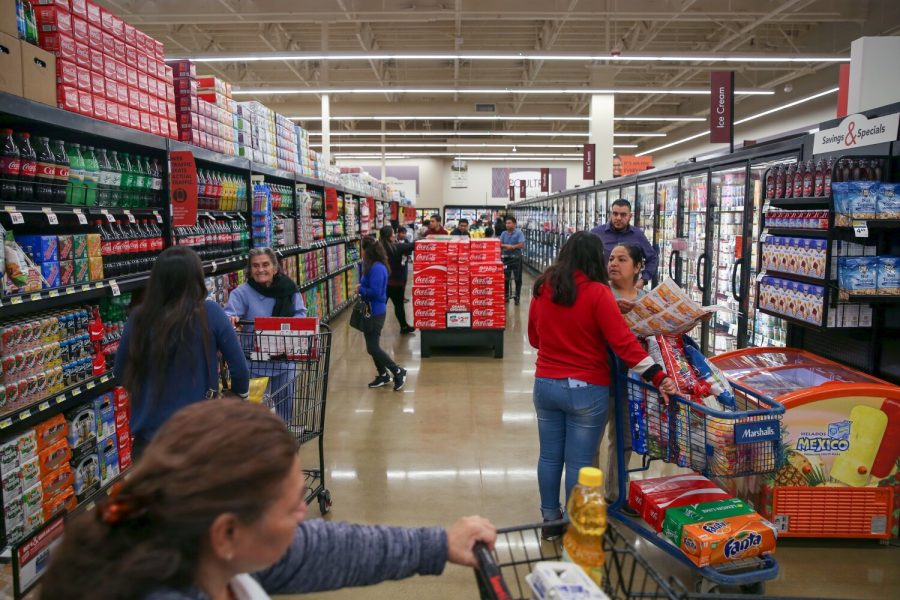[Opinion] Food deserts create disastrous short and long term effects
Tribune News Service
People shop during the Grand Opening of a Smart & Final Extra! at Jordan Downs Plaza, in Watts on January 8, 2020 in Los Angeles, California. The grocery store is providing fresh food in what is currently a USDA-designated food desert, a community in which at least 33 percent of the population resides more than 1 mile from a supermarket or large grocery store. Photo permission from Dania Maxwell/Los Angeles Times/TNS.
February 13, 2023
Regardless of gender, political affiliation, skin color or income, all humans must have certain basic needs fulfilled in order to live. On the simplest level, food is integral to survival as it contains the nutrients that provide energy to power almost every aspect of our bodies. Maintaining a healthy diet is essential as it lowers the risk of chronic diseases.
Despite this, across the United States, accessing healthy and nutritious foods is not always easy, which can lead to disastrous short and long term health effects. Areas where it is hard for people to access fresh, healthy and affordable produce, are often called food deserts.
Food deserts are often in areas that have been marked by socioeconomic disadvantage, resulting from a long history of discriminatory policies against minority households.
Over the last several decades in the U.S., supermarket chains followed white Americans into wealthy suburbs, even as many Black Americans remained in cities. This practice has been called “supermarket redlining,” echoing the earlier redlining that restricted mortgage lending in predominantly Black neighborhoods.
According to a 2014 study from Johns Hopkins University, which compared U.S. census tracts of similar poverty levels, in urban areas, Black communities had the fewest supermarkets, while white communities had the most. Multiracial communities fell in the middle. In order to qualify as a food desert, an area must meet other criteria. In urban areas, at least 500 people, or 33% of the population, must live more than one mile from the nearest large grocery store. In rural areas, they must live 10 miles away.
Food deserts are seen more commonly in areas with small populations and higher rates of abandoned or vacant homes. They are usually composed of residents who have less education, lower incomes and higher rates of unemployment. Social determinants of health, racial residential segregation and poor access to transportation among low-income and historically marginalized populations are often also food deserts.
Another barrier is that healthier foods are generally more expensive than unhealthy foods. For instance, while the overall price of fruits and vegetables in the US increased by nearly 75% between 1989 and 2005, the price of fatty foods dropped by more than 26%. With recent inflation, the higher cost of healthy foods often puts them entirely beyond the monetary means of many families.
Diet and nutrition play a major role in chronic disease, so having little to no access to nutritious foods can be detrimental to the health of millions. Eating high amounts of processed foods, fast food and sugar can lead to obesity, type II diabetes and cardiovascular disease.
Due to a lack of healthy food options and the easy accessibility of fast food, individuals living in food deserts are at an elevated risk for obesity. The Trust for America’s Health organization found in a 2022 State of Obesity Report that 4 out of every 10 American adults are obese.
Among low-income and food-insecure communities, disproportionate access to affordable, healthy foods contributes to poor nutrition and perpetuates health disparities, leading to higher rates of obesity and other chronic ailments. A vicious cycle has developed in which people with chronic diseases in food deserts rely on convenience stores, which often sell expensive foods with low nutritional value, further limiting people’s capacity to buy healthy foods.
Despite these difficulties, numerous solutions have been generated in order to improve access to affordable, healthy food: encouraging more local markets, starting a community garden and federal food assistance programs. One federal program named the Child and Adult Care Food Program provides reimbursements for nutritious meals and snacks to eligible children and adults who are enrolled for care at care centers.
Local food pantries and soup kitchens offer food to low-income communities to reduce food insecurity and hunger. Organizations such as Meals on Wheels provide medically tailored food delivery and nutrition education to establish racial, social and health equity.
When thinking of solutions, it is important to recognize the long-standing racial and socioeconomic roots of a food desert. There should not be a temporary fix that continues to perpetuate wealth inequities and health disparities, such as adding more fast-food chains.
Simply increasing access to cheap food does not lead to equitable access to affordable and healthy foods. Instead, there needs to be long-term, significant change within these communities. Every human, regardless of their skin color, salary or location deserve easy access to healthy and nutritious foods.
This story was originally published in the February 2023 Eagle Eye print edition.











